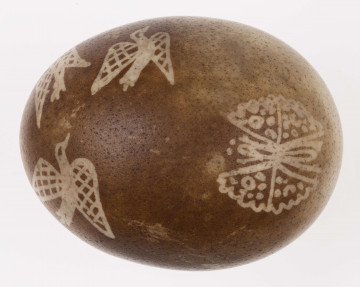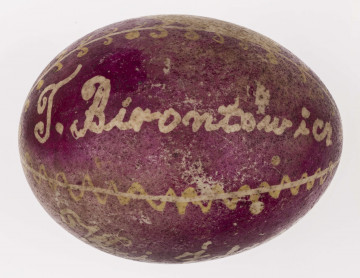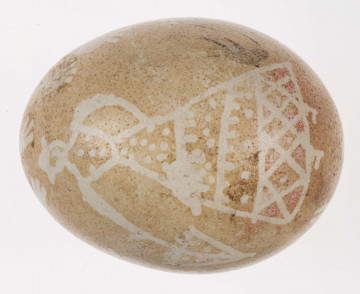
Easter egg
1901 — 1920
National Museum in Lublin
Part of the collection: Folk Art of the Lublin Region (17th–1st half of the 20th c.)
An Easter egg is an attribute of Easter, while an egg was a symbol of life, fertility, love and strength, and the symbolism of ornaments written on it played an important magical role. In the Lublin region, eggs were most often decorated with batik technique which consisted in writing a pattern with melted wax with the help of a pen made of sheet in the form of a funnel, set on a stick (see also E/1117/ML).
The division of patterns on eggs very often took the form of a cross, filled with additional plant ornaments. The cross itself was also a decorative motif, sometimes in combination with a swastika. The shape usually resembled a Greek or Maltese cross, with four equal arms, the symbolism referring to ancient meanings. Two lines crossing each other at right angles are the oldest symbolic representation of the image of the world (imago mundi), marking the centre and ordering it at the same time. It also symbolised the earth axis, the four sides of the world, the combination of opposites: life-immortality, spirit-matter, zenith-nadir, east-west, up-down, right-left. With time, the sign, enriched with lines, spirals and circles, began to symbolise the sun and life, both earthly and afterlife. It was a talisman used in sympathetic magic to induce fertility of the soil or worn to ward off demons (due to its resemblance to a sword) and other supernatural powers. The Latin cross as a sign of Christ's Passion appeared very rarely on Easter eggs in Lublin.
In the ethnographic collection of the National Museum in Lublin, there are approximately 2500 Easter eggs made by artists from the Lublin region. Most of them were made in the years 1950-1980, but a significant proportion (around 500), unfortunately of unknown authorship, date from the early 20th century. This Easter egg is one of the oldest.
Author / creator
Dimensions
cały obiekt: height: 5 cm
Object type
Easter egg
Technique
batik
Material
wax, egg, plant-based pigment,
Creation time / dating
Creation / finding place
Owner
The National Museum in Lublin
Identification number
Location / status

1901 — 1920
National Museum in Lublin

1901 — 1920
National Museum in Lublin

1901 — 1920
National Museum in Lublin
DISCOVER this TOPIC
Museum of King Jan III's Palace at Wilanów
DISCOVER this PATH
Educational path